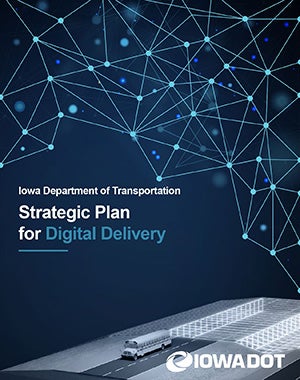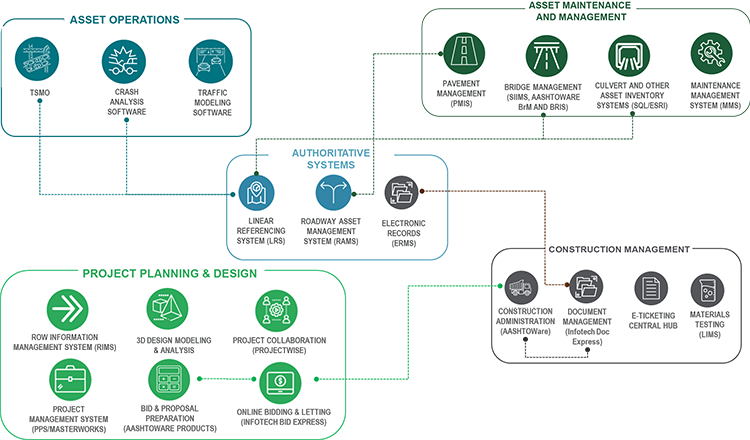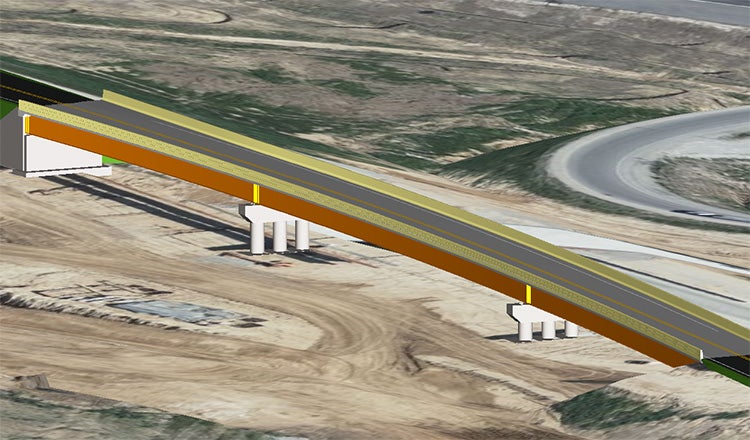
Statewide Strategy for Digital Delivery of Infrastructure
A Look Inside Iowa DOT’s Digital Delivery Strategic Plan
Digital delivery of infrastructure projects — using models and data-based information exchange — is becoming more and more common to streamline design and construction, and seamlessly share information through each phase of the asset management lifecycle.
The Iowa Department of Transportation retained HDR to help them develop a high-level strategic plan as their roadmap to integrate digital delivery throughout their agency. As one of the early adopters of Building Information Modeling for design and construction, the Iowa DOT has been providing 3D roadway models on a project-by-project basis since 2006, and piloting BIM for construction contract documents starting in 2018. Steady progress toward digital delivery has included systems for digitally tracking materials (e-tickets) and as-built records, data for managing asset maintenance, and a right-of-way inventory management system.
Digital delivery workflows will enhance the agency’s ability to share information seamlessly across the enterprise, manage assets effectively throughout their lifecycle, and provide greater value to external users of the digital deliverables, such as construction contractors and suppliers. Key goals and objectives of the DOT’s plan include:
- Developing consistent digital deliverables including 2D and 3D information that can be used by stakeholders to improve overall efficiency and provide the accuracy to support models as legal documents in the future
- Supporting new tools and leveraging existing technology to get the most from existing investments
- Managing assets using digital models that represent as-built conditions
- Implementing data management processes that align with Iowa DOT enterprise goals
Listening and Connecting

Iowa’s roadmap began with conversations with over 50 staff from 13 groups within the department, who shared how they obtain and access information to do their job, how long it takes to obtain information, and how they might do their job better. The objective of these interviews was to identify data uses and show the major activities and data exchanges between multiple stakeholders throughout the lifecycle of a project that could benefit from leveraging digital information contained in 2D and 3D models.
Findings were synthesized and reviewed to organise them into categories to assign the level of effort to advance progress. Findings were also examined to identify issues that could be addressed by existing agency working groups. For example, a current data governance initiative picked up findings related to how to govern, secure and manage data. An existing process improvement initiative picked up findings around document production.
Benefits to Design Through Construction and Asset Management
Several groups of workflows in the DOT will benefit from Iowa’s focus on advancing digital delivery, and agencies in other states would see similar benefits.
Engineering: The extensive collaboration that’s intrinsic to engineering design is made easier and more efficient through digital delivery and use of BIM. Traditionally an engineering plan is produced from design software and distributed as a PDF document for review among engineering disciplines. Each of the reviewers opens his/her own copy of the PDF plan, reviews it, and marks up comments which are then aggregated and addressed.
Iowa’s steps to continue toward a fully digital workflow offer the chance to increase efficiency and collaboration by providing a digital model (2D or 3D) for all reviewers to access in the cloud. Reviewers see the whole design in the model, navigate through it, and add comments that all reviewers can simultaneously view and reply to. There’s no need to aggregate comments. Resulting reviews are more efficient and are conducted with knowledge of the full context of the design and the comments from other disciplines.
Construction: Digital delivery can streamline construction planning and execution. Traditionally, contractors bidding a project would review a set of bid plans (typically 2D PDF plans) and create their own independent models for bidding and construction project planning and management. Iowa contractors have been receiving earthwork models directly from the Iowa DOT for a few years. In the future, Iowa contractors will receive a 3D model of the entire project (including earthwork, roadway traffic and signing, drainage, and bridges) and at the end of construction either the DOT inspection staff or the contractor will provide 2D as-built plans back to the DOT. By shifting to digital delivery throughout this workflow, more information (a full digital design model) can be provided to the contractor to communicate the design, and more information (a full as-built model) can be handed back to Iowa DOT upon construction completion.
As-Built Assets: Digital delivery of as-built plans after construction can provide a rich data set for asset management. A fully digital workflow that collects as-built condition data is valuable for operations and maintenance activities to identify asset location and condition. For example, by pulling forward construction records on materials (through e-ticketing) and capturing updates to the assets during construction (through digital as-builts) the DOT begins operating the asset with a full picture of asset characteristics and conditions.

Tactical Goals
Iowa DOT has prioritized their top tactical goals that may be accomplished within a one- to three-year period, and top strategic goals, which may take more than five years to complete.
Tactical goals begin with developing a stakeholder communication and engagement plan for digital delivery to help everybody understand why the changes are important. Guiding documents will explain the initiative so the workforce can adapt to changes and incorporate new digital delivery workflows.
Another key tactical goal is developing the information requirements to define what data the DOT needs to collect and why. For example, the information needed for design and construction is very different than that needed for operations and maintenance. The 3D models for construction contain information that communicate design intent and instructions regarding materials, measurements and payment for the different items in the model. The digital as-built models collected at the end of construction contain information that is important for operations and maintenance activities, such as location and accepted condition. Next steps will be to define the information required for key decisions during project delivery, such as what deliverables are needed at specific milestones and in what format, and what requirements must be developed to enable collecting digital as-builts.
Strategic Goals
Strategic goals focus on areas identified by the subject-matter experts that may require longer-term efforts to address, including:
- Standards: Developing and establishing standards and guidelines for naming conventions, data structure and geospatial connections across DOT systems.
- Systems: Adapting current plans for replacing the agency’s enterprise systems, as needed, to enable a truly digital workflow for searching and extracting data from record documents.
- Data Transfer: Streamlining processes for data sharing between various systems, such as Bid Express, ProjectWise, Masterworks, AASHTOWare, and BrM.

Pilot Projects
Implementing pilot projects is a good way to manage and scale adoption of digital delivery across the project lifecycle, working in collaboration with key external stakeholders. The digital delivery strategic plan calls for multiple pilot projects to test specific use cases. One pilot project will test data collection of digital as-builts once information requirements are in place. For example, a traffic sign is created during the design phase as a virtual representation of the object to be installed; then field staff verify that the digital version (design) of the sign matches the physical one installed by the contractor, using pre-populated forms that track the location and all the needed information for the maintenance system. These pilot projects will align to Industry Foundation Classes, or IFC, an open data standard that organizes infrastructure information as specific objects, making it possible to connect information about 3D model items developed in design and updated during construction to deliver a digital as-built model for operations.

Iowa’s Leadership Legacy
Iowa’s adoption of a digital delivery strategic plan is a natural outgrowth of its leadership in the adoption of 3D models as a standard practice. The DOT is actively involved in nationwide efforts, including multiple transportation pooled fund projects administered by the Federal Highway Administration:
- TPF-5(372) BIM for Bridges and Structures (involving 24 state DOTs) is establishing standards, guidelines, or manuals for bridge project stakeholders to facilitate the wide use of Industry Foundation Classes as an exchange standard in BIM for Bridges and Structures in bridge projects.
- TPF-5(480) BIM for Infrastructure (involving 18 state DOTs) advances the FHWA’s National Strategic Work Plan for BIM by establishing BIM processes and contract language, enhancing skills and building capacity, deploying data management tools and techniques, and exchanging information and lessons learned among states.
These industry-wide discussions provide important frameworks that enable the steady shift from traditional plan sets to 3D model deliverables.
Industry consensus is that before delivery of digital 3D models can become standard practice more must be done to develop standard object-based models and digital information exchange standards, and we must develop practical tools to make it easier for field staff to access digital models. Incorporating these digital tools into daily work will be key to benefiting from the added functionality of digital deliverables. As this standardization effort continues across the transportation industry, agencies interested in realizing the benefits would be well served by developing a high-level roadmap such as Iowa DOT’s Digital Delivery Strategic Plan.
For more information, BIMforInfrastructure [at] hdrinc.com (Contact HDR’s transportation digital delivery experts). We’d be happy to talk with you and share an update on the transportation industry movement toward digital delivery, lessons learned on pilot projects completed to date, and the best way forward.


